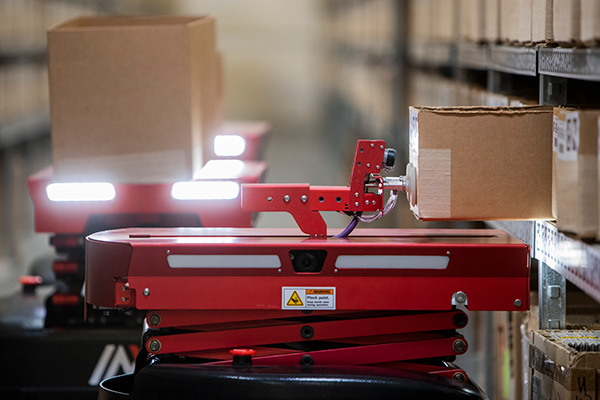Volume 24 | Issue 1

By Lior Elazary, co-founder and CEO, inVia Robotics
Then 2020 came along and changed everything.
It’s called a supply “chain” because every point in the process of supplying goods – from raw materials into packaged goods that end up in consumers’ hands – is connected and has an impact on the other points. It’s like a lineup of dominos. Remove one and the forward motion of the chain reaction is broken.
We saw this play out acutely in 2020 in e-commerce logistics, particularly at the hub of those operations – the warehouse. There were two key dominos that were removed: the labor needed to fill online orders and the ability to anticipate the pace of online orders being placed.

Let’s look at the labor piece first. It was complicated. First, as COVID-19 spread rapidly across the U.S., many warehouse personnel were sick and unable to come into work. Second, people were told to stay home and avoid going into other buildings except in emergency situations. It was hard to get enough people in warehouses to keep them running.
The other domino was removed from the demand side of the equation. While e-commerce sales had been steadily increasing over the last decade and putting pressure on fulfillment logistics, there was a realistic forecast in place. Businesses were able to plan for the annual increases in sales. Growth rates had been steadily coming in at 13-14% per year, until that doubled to more than a 30% increase in 2020. Most retail stores had been closed, forcing people to make all of their purchases online. Even for the stores that were allowed to stay open, they didn’t have enough employees available to come into work to keep operations running and consumers were scared to go into those stores for fear of getting sick. So on one end of the chain we had the labor supply removed, and on the other end we lost our ability to predict demand.
So, what do you do? You have to ramp the pace of fulfillment to keep up with demand. But you can’t bring more people into the warehouse and in some cases can’t even get your existing workforce back in. Inflation and wages are also increasing. So, what you have is also going to be more costly to keep. The answer is that you have to create more efficient processes, so you can do more with a smaller available pool of labor.
There is a lot of technology available now that will help you bring greater efficiency into your warehouse. But that means there are a lot of choices, and it can be overwhelming to know where to start. Big decisions are often best made by breaking them down into smaller ones. Warehouse optimization can be narrowed down to two major initiatives: digitization and automation. And these steps can be taken one at a time.
Digitization will lay the foundation for every other improvement you can make in your operations. Having reliable data, visibility into it, and intelligence that helps you interpret it in order to make smarter decisions is the best investment you can make. It will allow you to understand which tasks create critical paths and which people are best at completing them and then match those up to increase fulfillment speeds. And while it won’t be able to forecast external demand spikes from unforeseen pandemics, it will equip you with the intelligence to know your true internal capabilities and how you can flex those to keep up.
Then automation will compound the efficiencies and productivity improvements you’ll make from digitization. Being able to augment a scarce labor pool with always-available, always-on labor points is a game-changer. You can easily see 4-5X increases in fulfillment rates. Fortunately, while automation technology has significantly advanced, so have the business models of vendors who sell it.

Instead of traditional models where you had to spend millions of dollars to buy enormous pieces of equipment, you can now subscribe to receive services from the equipment without having to own and maintain it. In the industry it’s known as robotics-as-a-service (RaaS), and it’s turned out to be a perfect fit for the uncertainty of a pandemic. Not only does it allow businesses to spread costs over time and avoid big upfront capital outlays, it also makes it easy to take technology adoption one step at a time. With a services subscription, you can add or remove services from your monthly contract. Start by digitizing with your existing workforce. Add automation as you’re ready.
The COVID-19 pandemic was a reminder of just how important supply chain planning is to business operations. When done properly it gives us alternative paths to take when things don’t go as planned. Technology is a critical component of any supply chain strategy. It gives you intelligence about your operations that allows you to see where you can make adjustments and how they affect the rest of the chain. It’s true what they say: Knowledge is Power.

Lior Elazary
About the Author:
Lior Elazary has more than 20 years of experience as an executive in internet networking, robotics, software development and enterprise architecture businesses. He has led and directed diverse teams developing everything from back-office systems to core enterprise technologies. Most recently, he co-founded and later sold EdgeCast, a content delivery platform with customers such as Twitter and YouTube. Before that, he co-founded and later sold HostPro (now Web.com), an internet hosting company.
Elazary completed a master’s degree in computer science at the University of Southern California (USC) with a specialty focus on artificial intelligence. He attended a Ph.D. program in robotics at USC, where he met his inVia co-founders. Their work together sparked a passion for the dramatic effect robots can have in driving efficiency and productivity and, most importantly, in helping people live happier and more fulfilling lives.
In this episode, I sat down with Beejan Giga, Director | Partner and Caleb Emerson, Senior Results Manager at Carpedia International. We discussed the insights behind their recent Industry Today article, “Thinking Three Moves Ahead” and together we explored how manufacturers can plan more strategically, align with their suppliers, and build the operational discipline needed to support intentional, sustainable growth. It was a conversation packed with practical perspectives on navigating a fast-changing industry landscape.